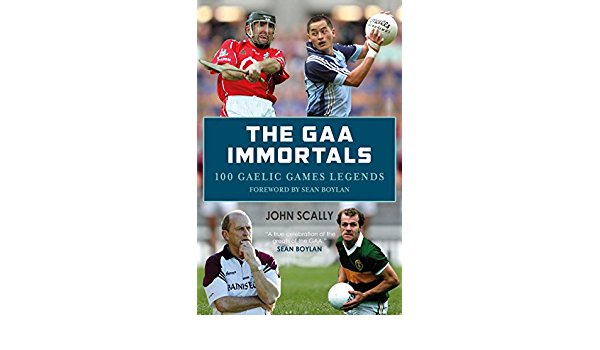The GAA Immortals: 100 Gaelic Games Legends
by John Scally (Black & White Publishing, €21.00)
This is a compilation of biographical sketches of footballers, hurlers and team-managers who were household names in the GAA world during the last 100 years.
The list of 55 footballers begins with Dick Fitzgerald. He won five All-Ireland championships for Kerry and was the first man to captain a county to consecutive All-Irelands in 1913 and 1914. He published How to Play Gaelic Football in 1914, the first handbook of its kind in the GAA. Following the 1916 Rising, Fitzgerald found himself with other Irish Volunteers in an internment camp at Frongoch in Wales. This did not unduly impact on his playing football, as in the competitions organised by the internees he captained the Kerry team.
The list of 45 hurlers begins with Christy Ring. Although some to-day might claim that accolade for Henry Shevlin, winner of nine All-Irelands, Ring’s contempories would be adamant that it belongs to him alone. The Cork maestro won eight All-Irelands, nine Munster championships, three National Leagues and no less than eighteen Railway Cups. When a video to demonstrate the skills in hurling was planned he was the obvious choice to feature in it.
Some of those who managed football and hurling teams were even more famous than their star players. It could be said that their contribution to the success of Gaelic games often more than matched that of their players. Seán Boylan trained Meath teams for 22 years, guiding them to victory in four All-Ireland finals. There was Mick O’Dwyer, who after preparing Kerry to win eight all-Irelands, subsequently managed Kildare, Laois and Wicklow. Then there is Micky Harte, icon of rectitude and proven master tactician.
Brian Cody’s stature as manager and coach is such that at the beginning of each hurling season the Kilkenny team are installed as favourites to win the All-Ireland. Other managers such as Jimmy Barry-Murphy, the colourful Davy Fitzgerald and Ger Loughnane have contributed in their own way to great hurling occasions.
Kevin Heffernan, both as a player and manager, was the person most responsible for the present-day popularity of Gaelic games in the metropolitan area. He won 13 county championships with St Vincent’s club. On graduating to the Dublin team he introduced the role of the roving full-forward. The success and style of the Dublin team he captained and later managed won many admirers and followers.
They described themselves as ‘Heffo’s Army’ and claimed Hill 16 as their own. The result is that now the fan-base for Gaelic games in Dublin more than matches that for rugby and soccer.
The author includes on his list football stylists such as Mick O’Connell, Maurice Fitzgerald, Seán Purcell and Jim McKeever and exceptional forwards such as Colm Cooper and Peter Canavan. He highlights the hurling skills of D.J. Carey and Joe Canning. Places are found on the list for Mick Carley (Westmeath), Mickey Kerins (Sligo) and Micky Quinn (Leitrim), outstanding footballers from counties who seldom feature in the later stages of the Championship or National League. Packy McGarty of Leitrim could also be included in this category. Of particular interest are the ‘dream teams’ in football and hurling selected by the listed players.
Regrettably just three ladies are mentioned: two camogie maestros – Angela Downey of Kilkenny and Ciara Gaynor of Tipperary – and Lulu Carroll who stared on Laois football teams.
When one considers the complexity of this subject John Scally provides a remarkable over-view of our Gaelic games. Ideal for serendipity this treasure trove of history and lore will be greatly cherished by the GAA community at home and abroad.


 The GAA Immortals: 100 Gaelic Games Legends
The GAA Immortals: 100 Gaelic Games Legends 